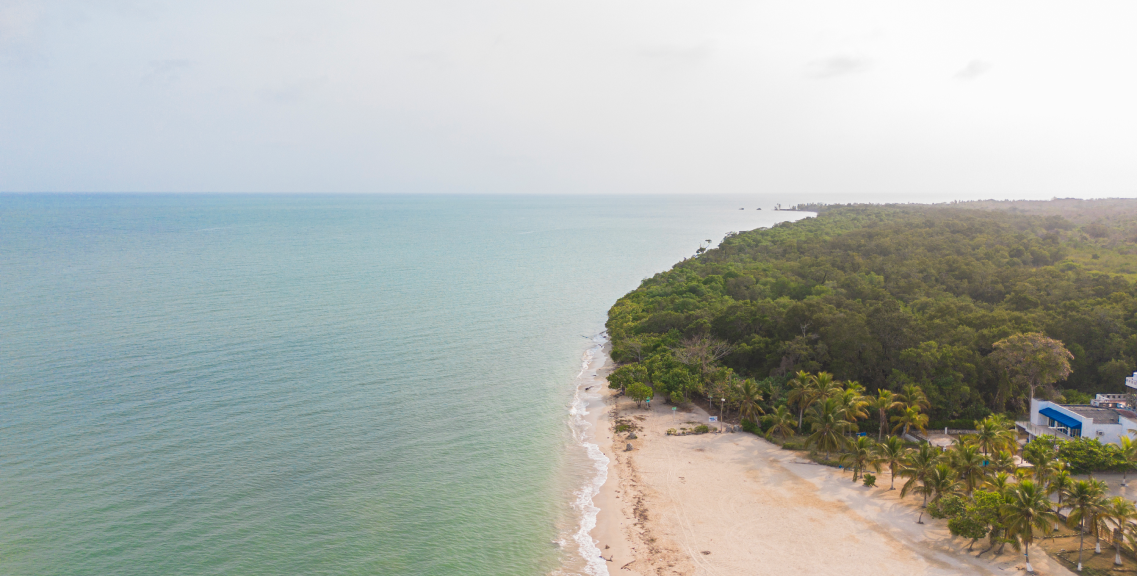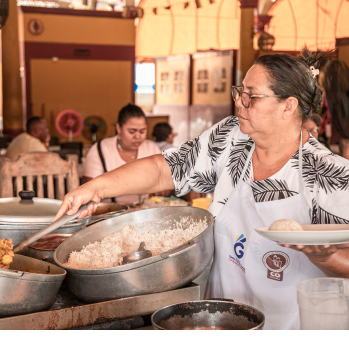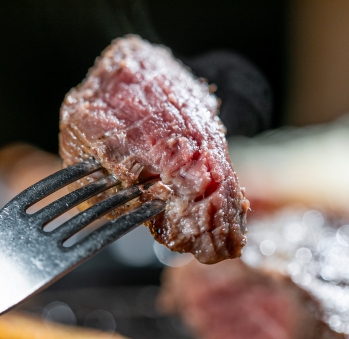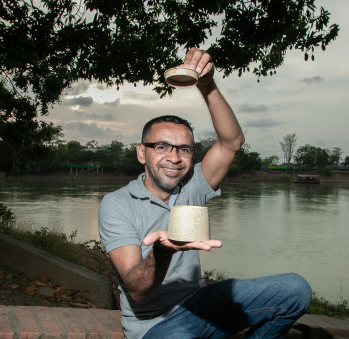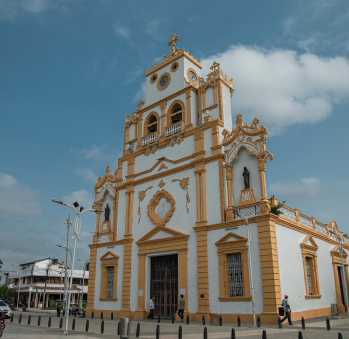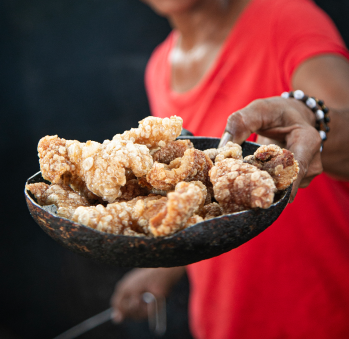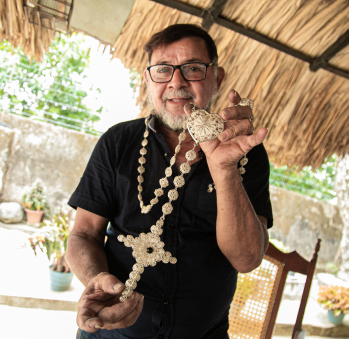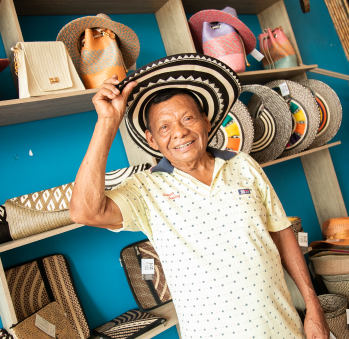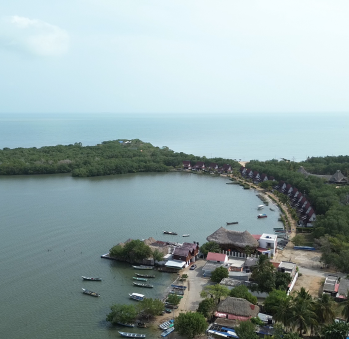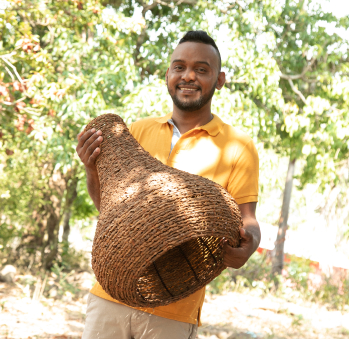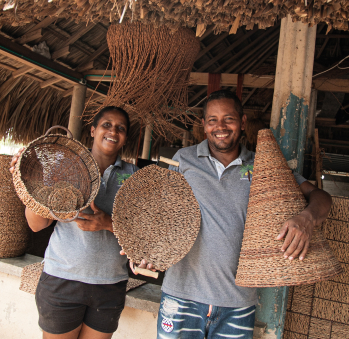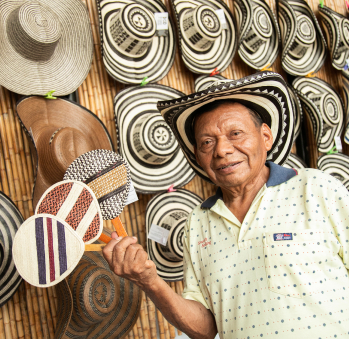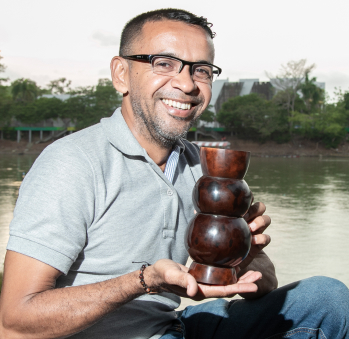Cordoba Route
On this route, it’s impossible to pass by without noticing the vast brown patch that colors the green plains that make up the landscape. This is the result of thousands of Romo Sinuano cattle, a breed native to the region, which makes this department the largest cattle producer in the country. Alongside these herds flows the mighty Sinú River, a 300-kilometer-long serpent that traverses the territory and shapes the lives of the Cordobans. Likewise, its mangroves and beaches in San Bernardo del Viento, Tolú, and Coveñas are sought-after relaxation destinations for tourists in search of tranquility. While these characteristics define the region and make it unique and marvelous, they are certainly not the only ones.
Córdoba is a land rich in craftsmanship, and a culinary paradise. We want you to witness firsthand the caña flecha in Tuchín, the raw material used to weave the renowned sombrero vueltiao, and to discover the palma de seje in Ayapel, which is used to create unique crafts in the country. We also want you to see how totumo is handled in San Antero and to immerse yourself in Lorica’s beauty. To truly complete this journey, you need to indulge in its delights. This route will be your opportunity to savor the fusion of culinary heritages resulting from the crossroads of cultures: indigenous and African roots, along with Syrian-Lebanese and Spanish influences. Taste the hearty mote de queso soup, loaded with yam, bocachico fish freshly caught and flavored with corozo juice, or a caraqueña de cola. Top it off with sweet coconut or guava treats, or a mongo mongo dessert made with plantains, cloves, and mamey. Enjoy their succulent meats and take a horseback ride through cattle farms. Each landscape brings its own flavor, and it’s well worth embracing delight because this department is full of wonders crafted by skilled hands.
Embark on a journey full of history
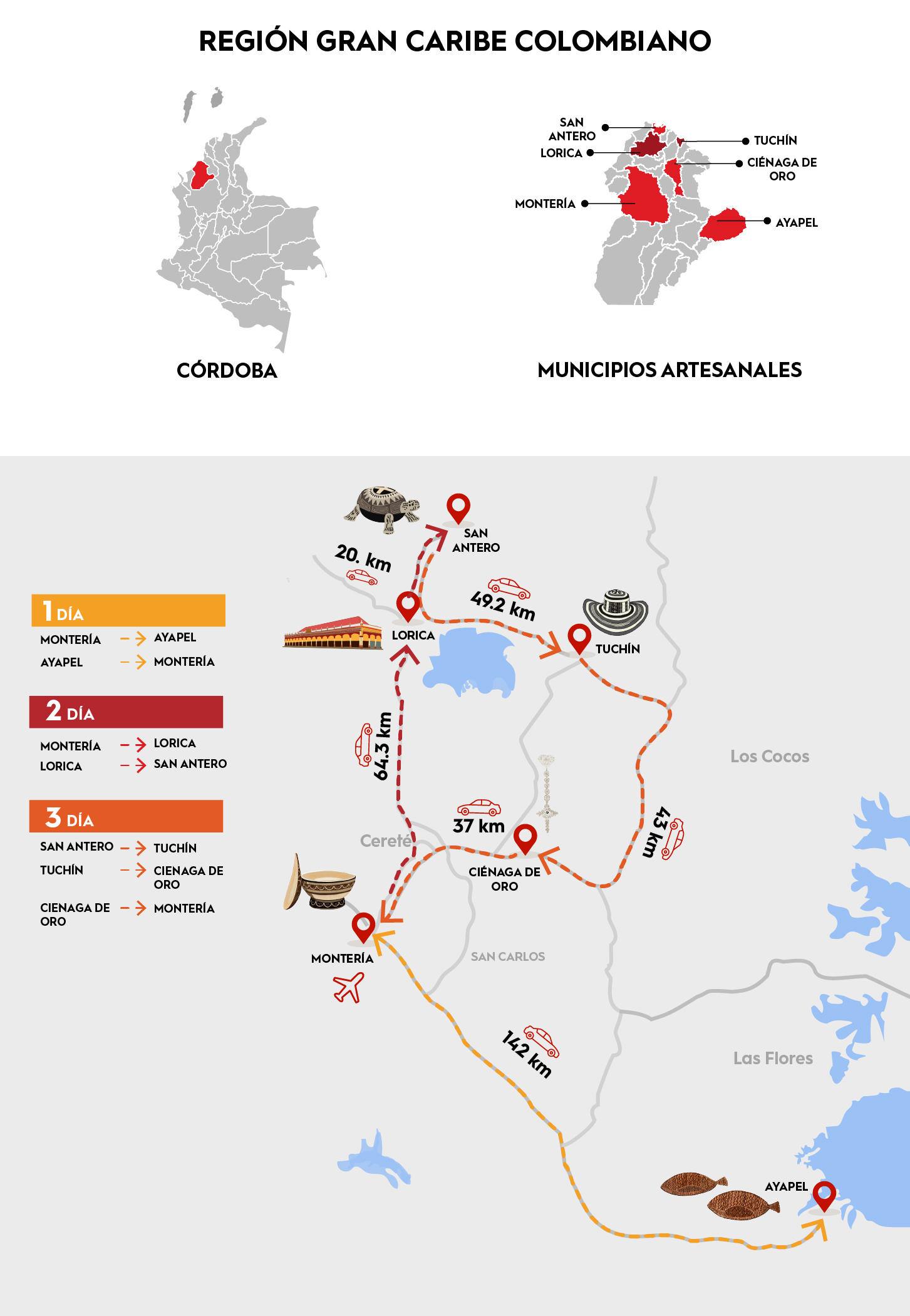
Artisans along the way
Artisans along the way
We recommended this tour
Schedule the visit in advance with the artisans
Carry cash
Carry hydration
Llevar snaks.
Preferably go with the tour operator.
Avoid going during the rainy season (June to December approx.)
Navegar el río con un motorista que conozca el Río Sinú
No nadar en el Río Sinú (muchos remolinos, muy traicionero)
Para llegar a El Cedro donde están los artesanos de Ayapel, tomar Lancha o Johnson 15-20min del puerto de Ayapel a El Cedro. Cuesta 4mil trayecto salen cada media hora desde las 5:00am hasta las 6:30pm
Be aware of boat schedules to organize your travels
3 days
Car, Bus and Boat

Montería– Ayapel – Montería
We recommend arriving early at Los Garzones Airport in Montería. The plan is to immediately head to Ayapel to visit our recommended artisans: Alcides Vides, Adriana Martínez, and Heriberto Chávez. It’s a relatively long journey of about 142 kilometers, so we suggest you make a stop along the way for having a generous breakfast. Despite the distance, the landscapes of Córdoba are splendid and make the trip very worthwhile. In Ayapel, you’ll discover a land where a unique Colombian craft thrives: palm weaving using the palma de seje. It will be an adventure as you take the popular Johnson boat, powered by an outboard motor, which the locals use to travel to El Cedro district. You won’t regret it. For lunch, we propose two options: either enjoy a variety of local snacks to fuel you for your visit to the town and then return to the capital to relish the diverse gastronomy of Montería at Compae Goyo or along the Sinú River’s promenade, a blend of meats, Syrian-Lebanese cuisine, Afro-Caribbean flavors, and traditional dishes; or you can spend more time in Ayapel, engage in birdwatching, and explore the marshes while trying river cuisine. To conclude the evening in Montería, we invite you to meet Juan Urán, a jeweler experimenting with totumo and seeds. Don’t miss a stroll along the Sinú River’s bank—a passage spanning over three kilometers, where birds grace the skies. Watching the sunset there and embracing the nightlife are experiences you shouldn’t forego. Montería offers a wide range of accommodations.
Montería – Lorica – San Antero
This will be a powerful day. We suggest starting your journey to Lorica, 65 kilometers away from Montería, to discover the beauty of this Colombian heritage town. Its intact republican architecture and proximity to the river evoke a sense of another era. As the birthplace of Afro-Colombian writer Manuel Zapata Olivella, his influence is evident throughout the town. Additionally, Lorica is the perfect place to delve into Cordoban culinary culture. The Lorica market is a must-visit, where you’ll find not only skilled cooks like Doña Mayo but also the aromatic spices that reveal the fusion of cultures, and the influence of the Arab world and its refined flavors in the Colombian coast. However, if you’re drawn to meats or traditional dishes, don’t miss trying the various cuts of local beef or dishes like mote de queso (yam and cheese soup) and freshly caught bocachico fish. There are also corozo, zapote, and mango juice, as well as sweets with charming names like mongo mongo and cabellito de ángel, which is made from pumpkin. With a satisfied heart and satiated belly, set out for San Antero, about 20 kilometers from Lorica. You can comfortably spend the night there. In this charming town, famous for its traditional Festival del Burro during Holy Week, you can visit Leider Guerrero, a totumo carver who will reveal the secrets of this fruit. Take one of his crafted animal figurines as a souvenir of your visit to a land of turtles, armadillos, and parrots. Also, explore the Calabazo Museum and take a stroll through its beautiful mangroves.
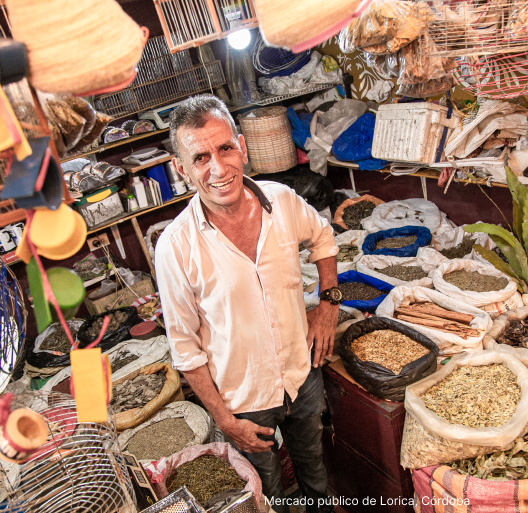
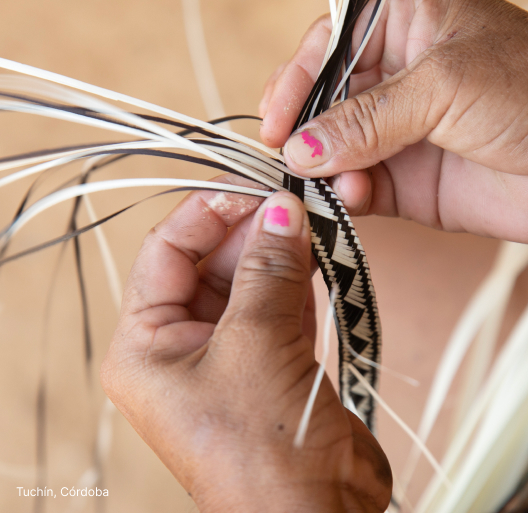
San Antero – Tuchín – Cíenaga de Oro – Montería
Final stop: Tuchín, homeland to the famous sombrero vueltiao. Located 50 kilometers from San Antero, prepare to discover the mastery of caña flecha, the raw material used to craft this national treasure. This town is steeped in artisanal craftsmanship. However, we’d like to introduce you to two true masters: Marcial Montalvo and Luisa Flórez. Next to them, you’ll gain a valuable initiation into this craft and a clear understanding of the process involving the fiber, natural dyeing, the handcrafting of braids ranging from 11 to 33 threads, and the crafting of the distinctive pintas or symbols that give hats their outstanding character. The true charm of the town lies in observing these artisans at work. Don’t hesitate to take home one of these incredible hats. Make sure to visit the lookout point from where you can view the town and its landscape in all its dimensions. If you’re keen on trying local treats, you can’t miss the lemon cookies, guava delicacies, or chicha. And if you prefer savory flavors, don’t skip the ají. As you return to Montería, a 45-minute drive, you’ll encounter Ciénaga de Oro, the land of the famous porro “La Aventurera,” by Pablito Flórez. Here, you can meet Diego Urán, a traditional jeweler who will be delighted to show you the 1897 bellows used by his grandfather, father, and himself to work filigree. With a fairly complete overview of Cordoban artisanal crafts, we bid you farewell and wish you a safe journey home!
Traditional cuisine
and typical bites
Provoke yourself
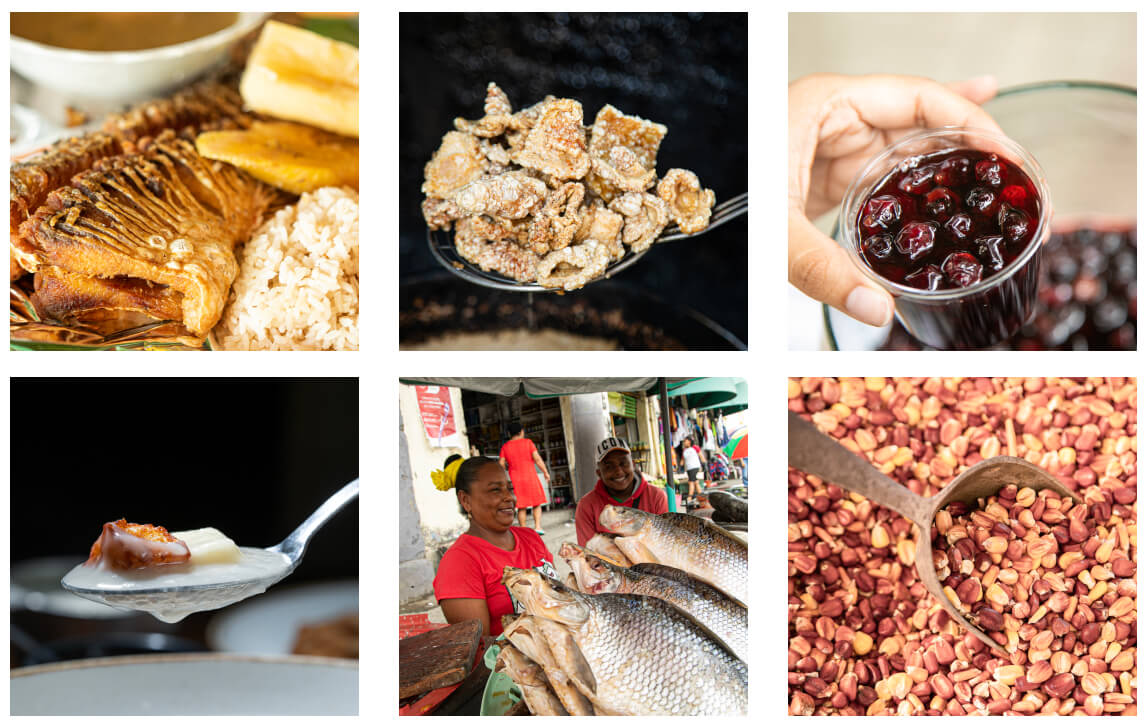
Don't leave without eating this 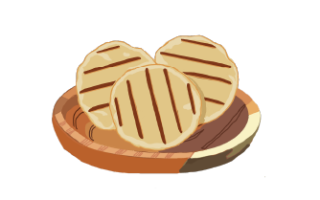
La carne de res en la gastronomía cordobesa colombiana es famosa por ser de excelente calidad, proveniente del mejor ganado seleccionado de las sabanas de Córdoba. Tiene una gran variedad de cortes, como el solomo, el solomito, el lomo ancho, la punta de anca, el muchacho, la posta, el pecho, el lagarto, la sobrebarriga y otros. En la región se ofrecen platos típicos y deliciosos, como la sobrebarriga casera a la colombiana, que se adoba con cebolla, tomate, laurel, sal, pimienta y cilantro y se cocina a fuego lento hasta que quede tierna y jugosa. Es famosa por el uso de estos cortes a la parrilla.
La Bonga del Sinú, es un lugar tradicional y reconocido, donde se puede degustar de una carne de res asada al carbón con diferentes salsas, como chimichurri, ají y hogao. En La Parrilla del Gordo o en Simón Parrilla, en Montería, también puedes disfrutar de esta magnífica gastronomía.
To lunch we go 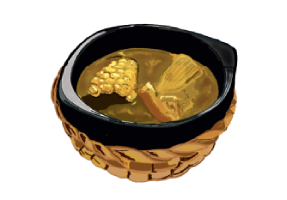
El mote de queso es un delicioso guiso de ñame y queso costeño con ajo, cebolla, limón y ají. ¡Ideal para acompañar con plátano maduro y suero!
El bocachico frito en leche de coco es un exquisito pescado de río que se fríe con leche de coco, cebolla, ajo y especias. ¡Una explosión de sabor caribeño! También el sancocho de bocachico es un nutritivo caldo de pescado con plátano verde, yuca y ñame. ¡Perfecto para reconfortar el alma! Paso obligado entonces por el Restaurante el Bocachico Elegante, en Montería.
Para probar estos platos, te recomiendo el restaurante La Zarapa Sinuana Campestre, en Montería, un lugar muy reconocido por su comida típica y su ambiente acogedor.
Flavors to discover and snack on 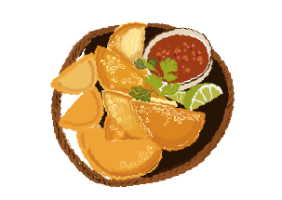
La Cabeza de gato es una pasta de plátano verde con ajo y mantequilla que se sirve como acompañante. ¡Un manjar para los amantes del plátano!
El suero atoyabuey es una delicia de la gastronomía cordobesa colombiana que no te puedes perder. Es una crema de leche ácida que se prepara de forma artesanal con leche fresca y cuajo. Tiene un sabor único y refrescante que acompaña cualquier plato típico de la región, como patacones, bollos o arepas.
To sweeten the palate and unmissable drinks 
El mongo mongo es un dulce de plátano maduro y panela con frutas como el mamey costeño, guayaba, piña, mango verde y papaya que se sirve frío y se puede acompañar con queso o galletas. Tiene un sabor suave y cremoso que te va a encantar. Su origen se remonta a la época colonial, cuando los esclavos africanos aprovechaban los ingredientes que les sobraban de sus amos para crear este manjar.
El dulce de ñame es un dulce hecho con ñame licuado, leche, azúcar, canela y vainilla, que se cocina a fuego lento hasta obtener una consistencia espesa. Se puede comer solo o con queso. Tiene un sabor dulce y aromático que te va a fascinar. Su origen se relaciona con la influencia árabe en la gastronomía española, que luego se trasladó a América con la conquista. El ñame es un tubérculo muy apreciado en la región Caribe por sus propiedades nutritivas y medicinales.
El dulce de tamarindo es un dulce hecho con tamarindo pelado, azúcar, agua y claras de huevo que se cocina hasta formar una jalea espumosa y dorada. Se puede comer solo o con galletas. Tiene un sabor ácido y refrescante que te va a sorprender. Su origen se debe al cultivo del tamarindo en la región Caribe, donde se le atribuyen propiedades digestivas y depurativas. El tamarindo es una fruta tropical originaria de África que llegó a América con los comerciantes portugueses.
El caballito de papaya verde o cabellito de ángel es un dulce hecho con papaya verde cortada en trocitos largos y delgados, azúcar y canela, que se cocina hasta obtener un almíbar espeso y brillante. Se puede comer solo o con queso. Tiene un sabor dulce y frutal que te va a encantar. Su origen se debe a la abundancia de papaya en la región Caribe, donde se le considera una fruta sagrada por sus beneficios para la salud. El caballito es el nombre popular que se le da al dulce por su forma alargada y delgada.
En todos los restaurantes se tiene al menos un dulce tradicional, pero si quieres probarlos todos visita las plazas de mercado de los diferentes municipios, seguro te sorprenderás.
El jugo de corozo y el jugo de zapote son dos bebidas tradicionales de la gastronomía cordobesa colombiana, que se preparan con frutas típicas de la región. El jugo de corozo tiene un sabor exótico y refrescante, y se dice que tiene propiedades antioxidantes y terapéuticas. Se hace cocinando los corozos en agua y luego licuándolos con azúcar. Algunas personas lo dejan fermentar por varios días para darle más sabor. De allí que también ha tomado gran importancia el vino de corozo. El jugo de zapote tiene un sabor dulce y cremoso, y se hace licuando la pulpa del zapote con leche, azúcar y hielo. Es una bebida muy nutritiva y energética, que se puede disfrutar en cualquier momento del día.
Si quieres probar estas deliciosas bebidas, puedes visitar los puestos de jugos de los diferentes municipios en el departamento o algunos de los restaurantes exponentes de la gastronomía cordobesa, como el Restaurante El Palmar y el Restaurante El Rancho del Sabor, en Ciénaga de Oro o el restaurante La Mula, en Lorica .
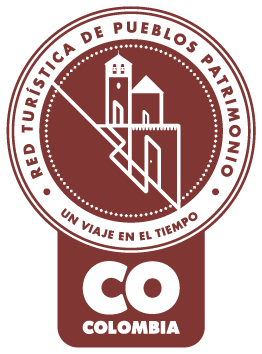
Pueblo Patrimonio
La Red Turística de Pueblos Patrimonio de Colombia es un programa especial del Ministerio de Comercio, Industria y Turismo, ejecutado por FONTUR, que trabaja con 17 municipios de Colombia que poseen declaratoria de Bien de Interés Cultural (BIC) a nivel nacional para su valoración y proyección mediante el turismo, generando así más oportunidades de desarrollo y sostenibilidad en las comunidades.

La Medalla a la Maestría Artesanal es un galardón que Artesanías de Colombia entrega anualmente, con el cual se hace un reconocimiento a aquellos artesanos, empresas y comunidades artesanales que, contando con una trayectoria destacada, sobresalen a nivel nacional por su excelencia en el oficio así como por preservar el quehacer artesanal.

Denominación de Origen
Es un signo distintivo que identifica productos reconocidos o famosos por tener una calidad o características específicas derivadas esencialmente del lugar de origen y la forma tradicional de extracción, elaboración y producción por parte de sus habitantes. La protección conferida sobre una Denominación de Origen implica que ninguna persona puede identificar con la denominación protegida productos iguales o similares a los amparados, cuando no provengan del verdadero lugar y no cumplan con las características o calidades que le han dado la reputación al producto reconocido. Las Denominaciones de Origen para productos artesanales colombianos que han sido protegidas por la Superintendencia de Industria y Comercio en nuestro país son actualmente 12.
No puede copiar contenido de esta página








































